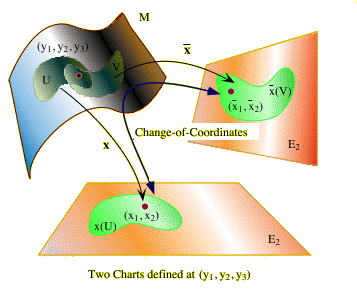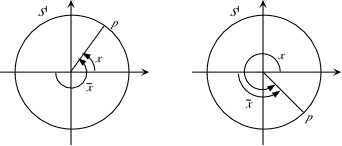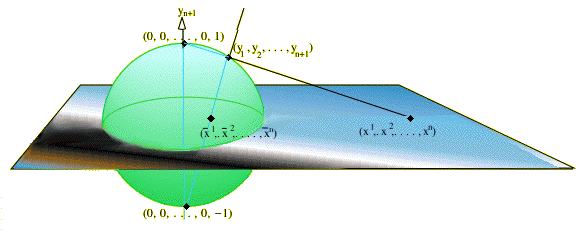Definition 2.1 An open cover of M  Es is a collection {Ua} of open sets in M such that M = Es is a collection {Ua} of open sets in M such that M =  aUa. aUa.
|
| Table of Contents | Back to Lecture 1: Preliminaries | On to Lecture 3: Tangent Vectors and the Tangent Space |
We now generalize the ideas discussed in Lecture 1.
Definition 2.1 An open cover of M  Es is a collection {Ua} of open sets in M such that M = Es is a collection {Ua} of open sets in M such that M =  aUa. aUa.
|
Examples
(a) Es can be covered by open balls.
(b) Es can be covered by the single (open) set Es.
(c) The unit sphere in Es can be covered by the collection {U1, U2} where

Definition 2.2 A subset M of Es is called an n-dimensional smooth manifold if we are given a collection
where:
(b) Each xar is a smooth (what does that mean?) real-valued function defined on U (that is, xar: Ua  th coordinate, such that the map th coordinate, such that the map
x(u) = (xa1(u), xa2(u), . . . , xan(u)) The tuple (Ua; xa1, xa2, . . ., xan) is called a local chart of M. The collection of all charts is called a smooth atlas of M. Further, Ua is called a coordinate neighborhood. (c) If (U, xi), and (V,  j) are two local charts of M, and if U j) are two local charts of M, and if U
 j) j)
with inverse
 k = k =  k(xl) k(xl)
for each i and k, where all functions in sight are smooth. These functions are called the change-of-coordinates transformations.
 |
By the way, we call the "big" space Es in which the manifold M is embedded the ambient space.
Notes
1. Always think of the xi as the local coordinates (or parameters) of the manifold. We can paramaterize each of the open sets U by using the inverse function x-1 of x, which assigns to each point in some neighborhood of En a corresponding point in the manifold. Let me see an example.
2. Condition (c) implies that
| det |
| 0, | and |
| det |
| 0 | , |
since the associated matrices must be invertible.
3. The ambient space need not be present in the general theory of manifolds; that is, it is possible to define a smooth manifold M without any reference to an ambient space at all -- see any text on differential topology or differential geometry.
4. More terminology: We shall sometimes refer to the xi as the local coordinates, and to the yj as the ambient coordinates. Thus, a point in an n-dimensional manifold M in Es has n local coordinates, but s ambient coordinates.
Examples 2.3
(a) En is an n-dimensional manifold, with the single identity chart defined by

One has
 : S1-{(-1, 0)}
: S1-{(-1, 0)}  < 2
< 2 , and the change-of-coordinate maps are given by
, and the change-of-coordinate maps are given by
 |
= |
|
| x | = |
|
Notice the symmetry between x and  . Also notice that these change-of-coordinate functions are only defined when
. Also notice that these change-of-coordinate functions are only defined when 
0,
. Further,
 /
/ = 1.
= 1.
Note that, in terms of complex numbers, we can write, for a point p = eiz  S1,
S1,
 = arg(-z).
= arg(-z).
(c) Generalized Polar Coordinates Let us take M = Sn, the unit n-sphere,
 En+1 |
En+1 | with coordinates (x1, x2, . . . , xn) with
In the homework, you will be asked to obtain the associated chart by solving for the xi. Note that if the sphere has radius r, then we can multiply all the above expressions by r, getting
(d) The torus T = S1 S1, with the following four charts:
S1, with the following four charts:
 (S1-{(1, 0)})
(S1-{(1, 0)}) , sin
, sin ), (cos
), (cos , sin
, sin )) =
)) = 
 , sin
, sin ), (cos
), (cos , sin
, sin )) =
)) =  .
.
(e) The cylinder (exercise)
(f) Sn, with (again) stereographic projection, is an n-manifold; the two charts are given as follows. Let P be the point (0, 0, . . , 0, 1) and let Q be the point (0, 0, . . . , 0, -1). Then define two charts (Sn-P, xi) and (Sn-Q,  i) as follows. (See the figure.)
i) as follows. (See the figure.)

If (y1, y2, . . . , yn, yn+1) is a point in Sn, let
|
|
|||||||||
|
|
|||||||||
| . . . | . . . | |||||||||
|
|
We can invert these maps (that is, solve for the global coordinates yi in terms of the local coordinates xi and  i) as follows:
i) as follows:
Let r2 = i xixi, and
 2 =
2 = i
 i
i i. Then:
i. Then:
|
|
|||||||||
|
|
|||||||||
| . . . | . . . | |||||||||
|
|
|||||||||
|
|
The change-of-coordinate maps are therefore:
| x1 | = |
|
= |
|
= |
|
|||||||||
| x2 | = |
|
|||||||||||||
| . . . | |||||||||||||||
| xn | = |
|
|||||||||||||
This makes sense, since the maps are not defined when  i = 0 for all i, corresponding to the north pole.
i = 0 for all i, corresponding to the north pole.
Note
Since  is the distance from
is the distance from  i to the origin, this map is hyperbolic reflection in the unit circle;
i to the origin, this map is hyperbolic reflection in the unit circle;
|
|
and squaring and adding gives

That is, project it to the circle, and invert the distance from the origin. This also gives the inverse relations, since we can write
 i =
i =  2xi = xi/r2.
2xi = xi/r2.
In other words, we have the following transformation rules.
|
Change of Coordinate Transformations for Stereographic Projection
Let r2 =
Note We can put all the coordinate functions xar: Ua
 En. En.
A more precise formulation of condition (c) in the definition of a manifold is then the following: each Wa is an open subset of En, each xa is invertible, and each composite
is a smooth function defined on an open subset. We now want to discuss scalar and vector fields on manifolds, but how do we specify such things? First, a scalar field.
If
Examples 2.5
(a) Let M = En (with its usual structure) and let (b) Let M = S2, and define
(c) Local Scalar Field The most obvious candidate for local fields are the coordinate functions themselves. If U is a coordinate neighborhood, and x = {xi} is a chart on U, then the maps xi are local scalar fields. Sometimes, as in the above example, we may wish to specify a scalar field purely by specifying it in terms of its local parameters; that is, by specifying the various functions  j = j =  j(xh). j(xh).
Example 2.6 Look at Example 2.5(b) above. If you substituted Exercise Set 2 1. Give the paraboloid z = x2 + y2 the structure of a smooth manifold. 2. Find a smooth atlas of E2 consisting of three charts. 3. (a) Extend the method in Exercise 1 to show that the graph of any smooth function f: E2 4. Two atlases of the manifold M give the same smooth structure if their union is again a smooth atlas of M.
5. Consider the ellipsoid L
(a, b, c 6. Find the chart associated with the generalized spherical polar coordinates described in Example 2.3(c) by inverting the coordinates. How many additional charts are needed to get an atlas? Give an example. 7. Obtain the equations in Example 2.3(f).
Copyright © Stefan Waner |